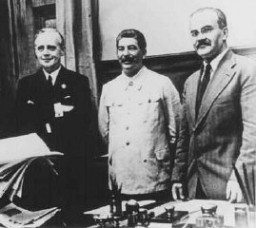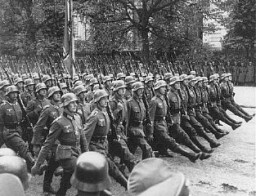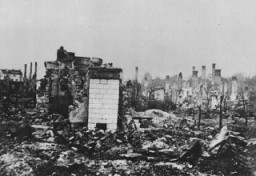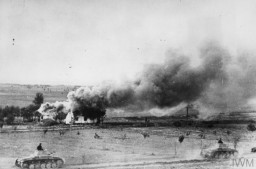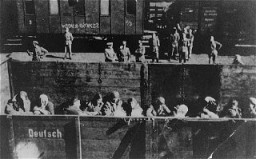
What does war make possible?
Persecution of Jews and other targeted groups was already government policy in Germany once the Nazis were in power in 1933. But following the German invasion of Poland on September 1, 1939, war provided the opportunity and motivation for more extreme Nazi policies.
The 80th anniversary of the outbreak of World War II provided an opportunity to reflect upon fundamental questions about the role of war. What possibilities did the onset of World War II create?
See related articles for background information related to this discussion.
World War II in Europe began on September 1, 1939, when Germany invaded neighboring Poland. War presented the Nazi leadership with opportunities and challenges. Here were more opportunities to turn ideology into practice in a broader geographical area, under the cover of a fight for national survival. Many Germans believed that Jews and hostile foreign powers had forced this fight on Germany. The war enabled Nazi Germany to take the implementation of its racial ideology to a new level. Its propagandists portrayed the invasion of Poland as a defensive measure necessary to defend Germany from its enemies.
Nazi beliefs or ideology were based on extreme forms of racism and antisemitism. Among the goals of Nazi racial ideology were the creation of a racially defined “people’s community;” the expansion of territory by conquering living space (Lebensraum); and the defeat of Germany’s enemies, internal and external. The Nazis perceived Jews as an existential threat to the German people and as their primary racial enemies.
The German occupation of Poland was brutal. The Nazis sought to destroy the Polish nation. To that end, they targeted anyone they thought might resist German rule or try to maintain Polish culture. German police, SS, army units, and local German militias shot thousands of ethnic Poles and Jews, including priests, political leaders, school teachers, prisoners of war, and hostages. The Germans also put the population to forced labor, incorporated territory into the Reich, requisitioned food and other property, and looted or destroyed cultural assets, including libraries, artwork, and archives.
Most of the people whom the Nazis and their collaborators would eventually murder fell under Germany’s control through military victories. In occupied Poland, Nazi officials had a large Jewish population under their control. Solving “the Jewish question” was one of Nazism’s main goals. With the war, it became a war aim, even if the means were still not clear. Almost 2 million of the 3.3 million prewar Jewish population of Poland lived in the German-occupied territories. 1.3 million lived in areas occupied by the Soviet Union under the terms of the German-Soviet Pact of August 1939, which had paved the way for invasion. In the following years, under the cover of war, the Nazis would seek a “final solution.” In the meantime, they forced Jews into crowded ghettos, deprived them of food and medicine, and used them for forced labor. Eventually, the Germans settled on organized mass murder of every Jew in Europe, a program they never could have implemented without war.
Wherever Hitler’s foot treads there is no hope for the Jewish people. Hitler, may his name be blotted out, threatened in one of his speeches that if war comes the Jews of Europe will be exterminated. The Jews comprehend and sense all that is in store for them wherever Hitler’s armies make a temporary conquest. —Diary of Chaim Kaplan, September 1, 1939.
Systematic killing of Germans with disabilities Wartime also presented Nazi leaders an opportunity to “cleanse” the “people’s community” by the systematic killing of disabled Germans. The Nazis saw Germans with disabilities as a genetic stain upon the German race and as a drain on resources that the nation needed for the war. In a secret note backdated to September 1, 1939, to use the war as a rationale and a cover, Hitler authorized the Euthanasia Program. Nazi leaders’ talk of “euthanasia” and “mercy death” disguised the fact that it was a program of mass murder for institutionalized patients with mental and physical disabilities. Its victims were transported from mental health facilities and other care institutions to special “euthanasia” centers equipped with gas chambers disguised as showers.
Under the appearance of wartime security measures, the camp system expanded into occupied territories. SS, police units, and the German army ruthlessly persecuted any individuals or groups that they believed were weakening the German war effort or represented a threat to the German people. Roma and Sinti, Jehovah’s Witnesses, resistance fighters from all over Europe, German deserters or soldiers who violated regulations, ordinary criminals, forced laborers who did not work hard enough, juvenile delinquents, homosexuals—all of these groups became targets. Millions more whom the Germans did not accuse of any crime were nonetheless rounded up for forced labor.
World War II and harsh German occupation policies provided the climate, opportunity, and rationale that propelled Nazi civilian and military leaders in Berlin and the field to move toward more extreme, murderous policies. The mass murder of the Jews, supported by local collaborators, began with the invasion of the Soviet Union in 1941 and escalated very quickly into the genocide of Europe’s Jews. By the end of 1942, four million Jews had been killed. Five million had been killed by D-Day, the June 6, 1944, Allied landings in occupied France. The Holocaust did not end until the Allied soldiers defeated Nazi Germany.
The genocide of Europe's Jews and the murder and exploitation of other targeted groups could not have happened without World War II and Germany's initial military successes.
